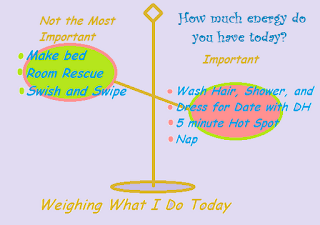Going back to your regular routine after a relapse or a flare can be a daunting task. I don't know about you, but I get used to sitting and lying around. I also start spending too long reading, watching TV, or playing games on my laptop. Last week, I sometimes felt bored, because I wanted to be active, but I felt awful. Not even the usual quiet pastimes kept me from feeling antsy about not doing my regular routine. But I know part of that was that I really felt too icky to have much of an interest in anything. However, I did use some of those times to throw in a load of laundry or wash some dishes. I was blessed to have some mobility, even though my energy didn't last long. I also used those times to care for myself -- rinsing out my sinuses with Neil - med, taking my medications, getting a healthy snack, and replenishing my water.
One of the problems for most people after an extended illness or a bad flare-up is getting back into a routine. Let's face it. When you lie around the house, you lose muscle mass. People with Fibromyalgia and Chronic Fatigue Syndrome already have problems with joint pain, muscle pain, and energy levels. Then there is that conundrum of having not been active, so you lose more energy by being inactive. It's walking the balancing beam again. If you have one of these illnesses, you have to learn to pace yourself. When you have been inactive, you have to start activity gradually, or you may walk yourself right back into bone-wearying fatigue.
Each of us has to learn our own balance and pacing. You don't what is right for me, and I cannot tell you what is right for you. Really -- only you know that; and, I can tell you from my own experience, it is a learning process. The first 12 years I began to experience the downs and ups of chronic illness, I tended to jump right into things full speed ahead, because I wanted to catch up. If I had a good day, I wanted to make the most of it. Experience and aging has taught me I cannot do that. If I push myself past my limits, I can expect another flare-up or relapse. Therefore, I thought I would share with you a break-down of how I get back into the swing of things. By the way, my swing is not quite as strong as it used to be, but at least I have gotten to a point where I can do the basic things I need to do at home. There was a time I could not do that. This doesn't leave energy for outside activities; but at least, I do feel like I am ministering to my husband. He doesn't have plans to retire anytime soon, and he is getting older too. I don't want him to feel like he always has to take care of me; although, I know he would if there was that need. When the need has arisen, he has definitely stepped up to the plate in doing things that have traditionally been my domain; however, I feel it is healthier for me physically, mentally, and emotionally when I can do my part.
First Day
- Take a shower and get dressed.
- Rest .
- Fix yourself a meal if you have not been fixing your own.
- Eat.
- Clean up after yourself.
- The rest of the day is yours to do with as you wish; Or, in one area of your home, spend 5 minutes picking up, if you feel strong enough.
- Rest.
- After my most recent flare, I actually had energy to fix a simple supper. I made that easier by sitting down to cut up the vegetables. Be mindful, that I have been doing some simple tasks like putting a load of laundry in the washing machine and dryer, so I have been doing light activity during my illness. And I had help with cleaning up the kitchen afterwards.
 Second Day
Second Day
- If necessary, take a shower. However, you might want to wait until later; because today, you will do more. Get dressed. I am not saying you cannot clean in your pajamas, because I have been known to do that; however, I like having on a comfortable house dress (something pretty) or comfortable jeans or skirt. Being dressed makes me feel ready for the day.
- After dressing, rest for a few minutes. Put your feet up. Perhaps you will want to make a short list of things that need to be done. Then pick three things off that list. Work at them no longer than 15 minutes each. You may need to cut the time for each activity to a shorter amount, depending on your strength. The key to getting back into your routine is adding things gradually.
- Make sure you rest between each activity. Put your feet up. I often work or play while sitting: ie. reading, working on a blog post ( which can be very tiring and time consuming), eating a snack, watching TV, or simply closing your eyes for a few minutes).
- You have to learn to listen to your body. That is not always easy for those of us who like to push through and finish an activity. However, I have learned that if I take a break and go back to what I was doing, I am more likely to have the energy to do what I need to do tomorrow.
I am learning not to sweat the small stuff. As capricious as chronic illness can be, we can still live our lives. I have to admit that I have lost some ground the last few years, but there are times I gain some ground. Worrying about what I can do or cannot do does me no good. It won't do you any good either. Worrying is an activity that drains the mind, body, and spirit. If you worry, you might as well picture yourself with a drain attached to your body. It makes things worse, not better. Believe me, I know! However, I have learned to let the anxious thoughts go. That isn't always easy, but it is possible.







